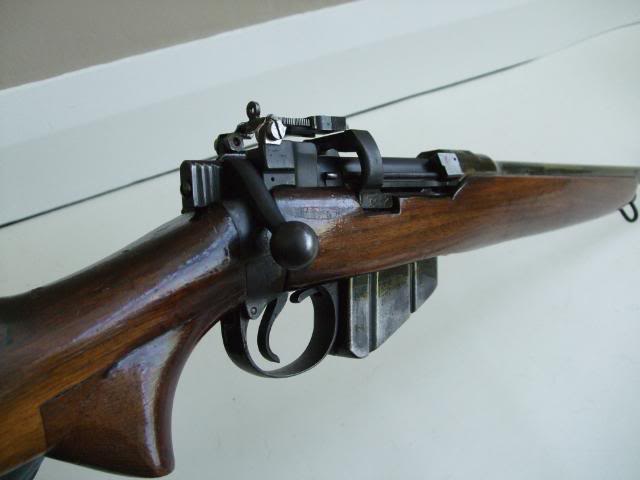-
FREE MEMBER
NO Posting or PM's Allowed

Screw hole dimensions on Shtle V rifle
I have a Shtle V rifle made in 1922. I want to try and make a scope mount bracket. Seems it has to mount on the left side of the receiver. There is a screw filled hole just below the bridge and seems I'll need to take off the rear sight and use the pivot screw hole. Does anyone know the actual dimensions for these two holes and the thickness of the sight bar protrusion ???
Thanks for any help you can offer
Information
 |
Warning: This is a relatively older thread
This discussion is older than 360 days. Some information contained in it may no longer be current. |
|
-
07-15-2012 08:16 PM
# ADS
Friends and Sponsors

-
Legacy Member

are you a friend of the devil
-
-
-
Legacy Member

The screw below the bridge is the ejector (screw). The thread on this is 0.165" dia., 37 threads/inch. This is an "Enfield Special" thread as it also has a unique thread "form", like every other screw on a SMLE. Some folk manage to make metric screws fit here, but it is not a good look
My experience with several commercial mounts that are supposed to be "easy-fit" in the manner you mention, has not been entirely positive. Most end up on odd alignments. Furthermore, anything but the shortest, lightest scopes will rapidly cause the entire assembly to flog around and become loose (and useless) in short order.
If you want a .303 with a scope, there must be a million "sporters" out there, going for a song. Keep and use the Mk5 in it's original trim: they are a classy and interesting beast.
Cheers.
-
The Following 5 Members Say Thank You to Bruce_in_Oz For This Useful Post:
-
I entirely agree with Bruce in Oz. Keep the grand old lady as she was meant and designed to be. There's no such thing as a successful fit's-all mount for a No1 rifle
-
-
Legacy Member


-
The Following 3 Members Say Thank You to paulseamus For This Useful Post:
-
Advisory Panel



Originally Posted by
stockerphil

I have a Shtle V rifle made in 1922. I want to try and make a scope mount bracket.
I don't believe for a minute he really intends to do this...I think he's just stirring.
-
Thank You to browningautorifle For This Useful Post:
-
stockerphil,
Agree with the others here, but maybe a few photo,s would help, as you may end up turning something like this,

into something like this

-
Thank You to bigduke6 For This Useful Post:
-
Advisory Panel


Pretty funny bigduke6, but you guys notice he hasn't been on since the 15th? Stiring...
-
-
FREE MEMBER
NO Posting or PM's Allowed

Weell what do you know
Yeah I haven't been on since the 15th. It was a serious inquiry, but with this info I will certainly reconsider. Thanks for the input. Had read there were only 20K made but don't know much beyond that. Also didn't really understand the picture shown under "Like This" But infere it is a kludge
Slugged the barrel and thought it measured .313, tho it might be .311. Difficult to measure with a micrometer. Bored a .313 hole in a piece of steel and slug fits but may have to bore .311 version to confirm. Bought .313 cast bullets so I can reload, but not sure now it is the right dia. Fortunately my Argentine 91 does slug .313 so can use the bullets there. Will .313 cast bullets work OK in a .311 Enfield?? One gunsmith said it should be OK. Sorry to be dumb but am just starting to try and do some shooting, haven't reloaded anything yet
91 does slug .313 so can use the bullets there. Will .313 cast bullets work OK in a .311 Enfield?? One gunsmith said it should be OK. Sorry to be dumb but am just starting to try and do some shooting, haven't reloaded anything yet
-
Legacy Member

Cast bullets can be good and bad.
You need to use the hardest alloy you can work with if you want any sort of velocity.
Also, unless you want "gallery loads" stick with heavy pills (180-200gn). They feed better too.
You will probably find that the actual groove diameter is a bit bigger than .313", unless you have a really odd one. Most LE barrels slug out to .315" up to .319". Make sure your test slug is at least .315", short and VERY soft.
Once you start using cast bullets, avoid using any jacketed stuff afterwards UNLESS you are absolutely confident that you can remove EVERY streak of lead alloy from the lands and grooves. I have seen some VERY expensive barrels wrecked by one round of jacketed ammo after a diet of cast bullets. The hard jacket simply "bulldozes" the metal fouling up the barrel until the steel of the barrel gives way, usually as the barrel thins out a few inches back from the muzzle. Hey! Presto! a "ringed" and ruined barrel.
Last edited by Bruce_in_Oz; 07-17-2012 at 11:02 PM.
Reason: typos
-















 Register To Reply
Register To Reply















